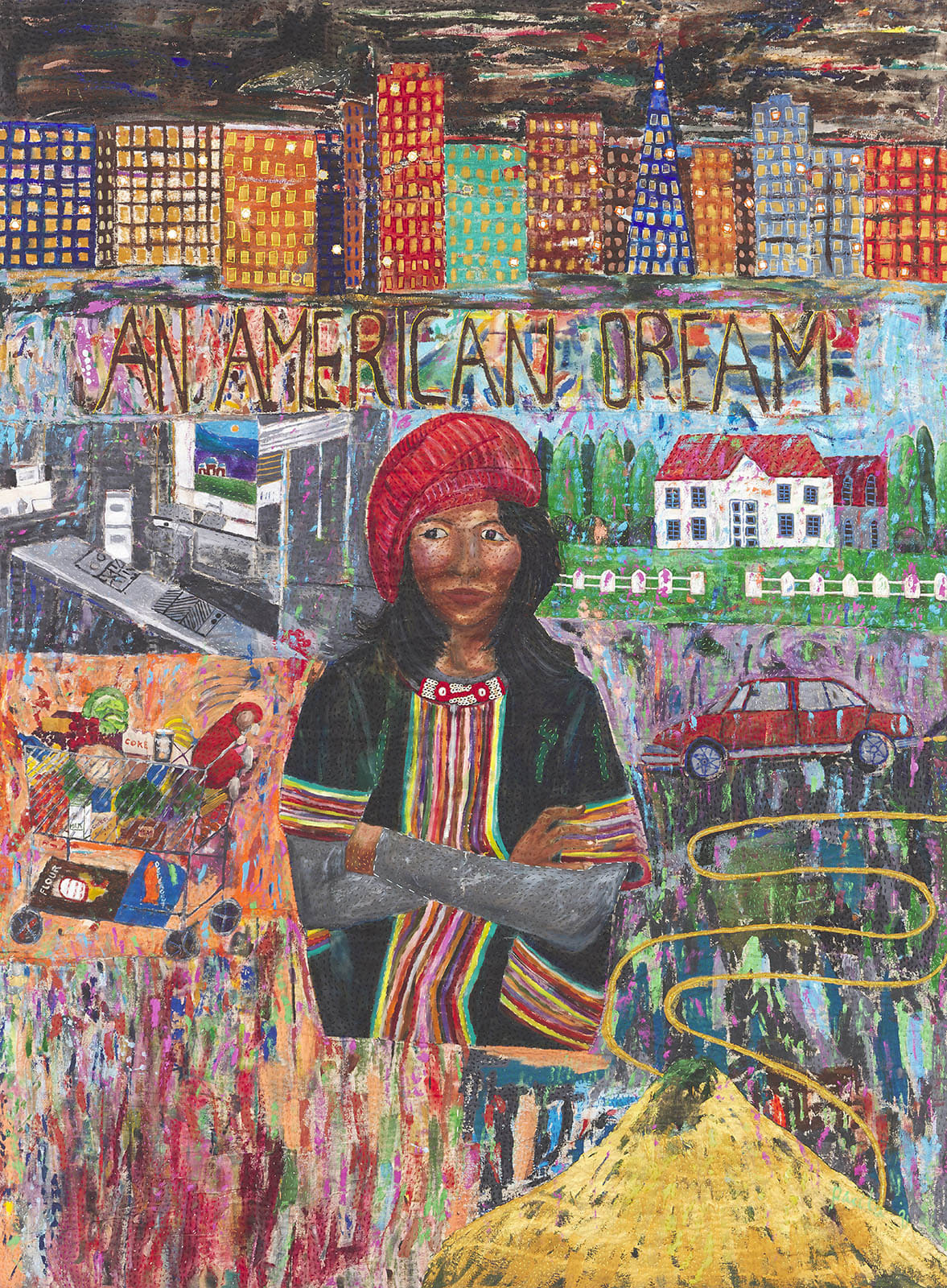“If my friends could see me now” 1991. Acrylic, painted canvas, gold yarn on stitched and padded canvas. 📸 Photo courtesy of the Pacita Abad Art Estate | currently on exhibit at The Walker Museum
by Isabella Silva-Biotti
The first time I ever saw Marco cry was after the sudden realization that he might never see his parents again. Of course this wasn’t the first time he’d known this – he knew. The first time he realized it was the day he left Mexico. “Vente aquí que hay dinero y trabajo,” his brother said. In a haste he began his odyssey to the United States.
Marco worked as a car cleaner, a mechanic, a repairman, a waiter, a cook, and many others. All of these professions were potential career paths but he never felt that he could reach the full potential that many Americans had the liberty to explore. When we worked together as servers at a Mexican restaurant in 2019, he encouraged me to pursue my passions because I was lucky enough to have the privilege of legality in a country where undocumented individuals are hunted and loathed.
25 years later, Marco hasn’t returned to Mexico. Thanks to technology he can facetime and text his parents. His son, who he admirably encourages to be his best self, was born in the U.S. and is reminded by his father to not forget his heritage. Marco shows his son that he can have the best of both worlds. The privilege of being an American with a Mexican heritage.
Immigration is often seen as a journey to liberation. New doors are opening while a troubled past is left behind. Immigration is a choice that can feel like a resignation, as Milan Kundera once said in his novel “Ignorance” (2000). Some are running from burdensome environments, but many immigrants are leaving behind their home and their loved ones.
The search for a better life is tough. The belief that once a person sets foot in U.S. territory their world magically transforms into a respectable, well-informed, educated U.S. citizen is a fallacy. Groups of people dwell on their past homes while they make means to form new ones. Not only is the economic aspect a difficult circumstance, but culturally transitioning into opposing and contradicting values is an enduring hardship. Either you come accustomed to the new ways, or you live a path of resistance.
According to Julisa Arce’s memoir “You Sound Like a White Girl: The Case for Rejecting Assimilation” (2022), many Latino individuals tend to resist the process of assimilation. In previous editions of NewPrensa, I have shared stories of older generations of Latinos who embraced American culture and assimilated into it. My own parents and their friends attempted to do the same, influenced by societal expectations to conform rather than blend their upbringing with newly introduced traditions.
Fadumo’s parents migrated to the U.S. as refugees in 1993. Six years later, Fadumo was born in St. Paul, and lived a Somali-American life until she left for Somalia in middle school. An experience that molded her into an adult, she got to see the two sides of the cultural coin.
Fadumo arrived in Somalia as a 12-year-old girl and experienced a cultural reset. To her surprise, the other girls her age were women. They were mature, responsible for their siblings, and cooked three times a day; tasks Fadumo expected a mother to do. Four years later, she returned to the U.S. and confronted her biggest cultural shock.
Having to rebuild her foundation for American life, the cultural reset weighed heavily on Fadumo as she had to fit in once again and become accustomed to the values she had forgotten. “I’m the barrier who’s lived in Somalia,” Fadumo said. “I’m a barrier for elders and the first generation Somali-American kids who never went to Somalia.”
Resisting assimilation can be a challenging task. In some cases, it may not be solely due to societal pressure to conform, but rather because of a lack of sufficient familiarity with one’s own inherited culture. As a result, individuals often find themselves aligning with what feels most familiar and closest to their sense of belonging. Nevertheless, there is often a sense of shame that accompanies the experience of straddling both sides of the cultural coin.
Striving for excessive assimilation towards one side or the other can present challenges. Either you’re perceived as too American or “white” by fellow Latinos, or you’re seen as too Latino by Americans. Y, entonces? Similar to the Chicano experience, you find yourself in a state of not fully belonging to either side. It’s a conflicting feeling where individuals yearn for a sense of belonging while grappling with uncertainty about which side to favor, although there may be a natural inclination towards one side in certain cases. What unfolds when these two aspects are combined?
Nonetheless, immigrants can bring transforming innovative waves of excellence to a culture whose crevasses allow a stream of newfound consciousness. Perhaps it’s the newcomers. In other instances, it’s the children of the immigrants who’ve fought for a place for their children’s future.
Bi-culturalism is seen as beneficial. Bi-cultural individuals are proficient in more than one language and comprehend at least two different cultures. It’s an oscillating lifestyle that develops another level of adaptability and complexing comprehension of what is beyond or that could combine. Bi-culturalism expands into our friendships, media preferences, or food tastes.
Schwartz and Unger (2010) dive into the essence of biculturalism and adaptability. They touch on cultural duality and explain that its development surges from “ethnogenesis”, which is the process of forming an ethnic group. Yet, assimilation or separation predominates the definition of bi-culturalism, demonstrating that in fact not everyone is bi-cultural despite living in an bi- or multi-cultural environment. Understanding the processes of acculturation will lead to a deeper comprehension of cultural identity and adaptation (Schwartz and Unger, 2010).
Ultimately, immigrants are not merely contributors to a new society; they are torchbearers of change, catalysts for transformation. Through their presence, they challenge existing norms, infuse fresh perspectives, and enrich the cultural fabric of their new home. It is in embracing and celebrating the multiplicity of cultural backgrounds that societies can truly thrive.

I’m Communications Specialists by day and a creative writer by night!
Do you enjoy reading NewPrensa?
Forward it to someone you think may enjoy it too!
Got suggestions, feedback, or a good scoop?
Send it to us at newprensa@newpublica.com
If someone sent this newsletter your way, feel free to subscribe to get local, BIPOC news



